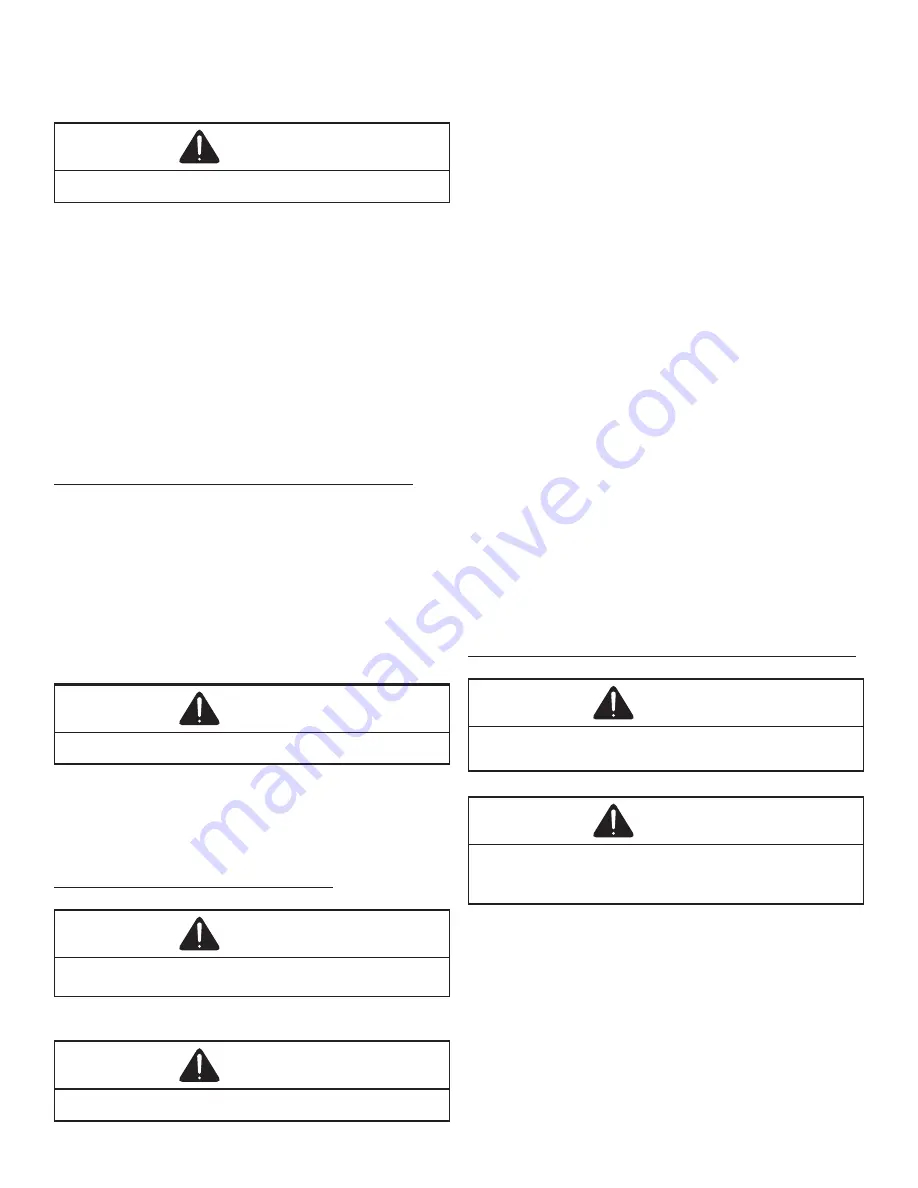
20
SERVICING
With power ON:
WARNING
Line voltage now present
1. Check the serial data plate for the compressor locked
rotor amps (LRA) rating.
2. Using an ampmeter, measure the amperage reading
for the run and common wires to the compressor.
Since the compressor motor overload will likely
trip soon after drawing locked rotor amps, this
measurement should be taken as soon as the
compressor starts.
3. If the amperage reading roughly equals the
compressor LRA rating and all other checks have been
completed, locked rotor amps has been verified.
S-18 Testing crankcase heater (Optional Item)
The crankcase heater must be energized a minimum of
four (4) hours before the condensing unit is operated.
Crankcase heaters are used to prevent migration or
accumulation of refrigerant in the compressor crankcase
during the off cycles and prevents liquid slugging or oil
pumping on start up.
A crankcase heater will not prevent compressor damage
due to a floodback or over charge condition.
WARNING
Disconnect ALL power before servicing.
1. Disconnect the heater lead in wires.
2. Using an ohmmeter, check heater continuity - should
test continuous. If not, replace.
S-100 Refrigeration Repair Practice
DANGER
Always remove the refrigerant charge in a proper
manner before applying heat to the system.
When repairing the refrigeration system:
WARNING
Disconnect ALL power before servicing.
1. Never open a system that is under vacuum. Air and
moisture will be drawn in.
2. Plug or cap all openings.
3. Remove all burrs and clean the brazing surfaces of the
tubing with sand cloth or paper. Brazing materials do
not flow well on oxidized or oily surfaces.
4. Clean the inside of all new tubing to remove oils and
pipe chips.
5. When brazing, sweep the tubing with dry nitrogen
to prevent the formation of oxides on the inside
surfaces.
6. Complete any repair by replacing the liquid line drier
in the system, evacuate and charge.
Brazing Materials
Copper to Copper Joints
- Sil-Fos used without flux
(alloy of 15% silver, 80% copper, and 5% phosphorous).
Recommended heat 1400°F.
Copper to Steel Joints
- Silver Solder used without a flux
(alloy of 30% silver, 38% copper, 32% zinc). Recommended
heat - 1200°F.
Aluminum to Aluminum & Copper to Aluminum Joints
–
ZA-1 Brazing Rods use Flux System Cesium-Based Polymer
System (alloy of 78% Zinc and 22% Aluminum). Melting
point 826*F Flow point 905*F.
S-101 Leak Testing (nitrogen or nitrogen-traced)
WARNING
To avoid the risk of fire or explosion, never use oxygen,
high pressure air or flammable gases for leak testing of
a refrigeration system.
WARNING
To avoid possible explosion, the line from the nitrogen
cylinder must include a pressure regulator and a
pressure relief valve. The pressure relief valve must be
set to open at no more than 150 PSIG.
Pressure test the system using dry nitrogen and soapy
water to locate leaks. If you wish to use a leak detector,
charge the system to 10 psi using the appropriate
refrigerant then use nitrogen to finish charging the system
to working pressure, then apply the detector to suspect
areas. If leaks are found, repair them. After repair, repeat
the pressure test. If no leaks exist, proceed to system
evacuation.
Содержание DP14UM
Страница 43: ...43 SCHEDULED MAINTENANCE Table 2 ...
















































